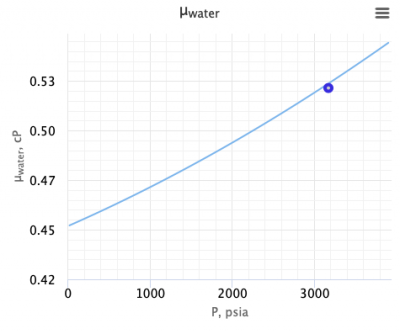Difference between revisions of "Water viscosity"
From wiki.pengtools.com
| Line 8: | Line 8: | ||
:<math> \mu_{w1} = AT^{-B}</math><ref name= M1991/> | :<math> \mu_{w1} = AT^{-B}</math><ref name= M1991/> | ||
| + | |||
| + | where | ||
| + | |||
| + | :<math> A = 109.574 - 8.40564 C_W + 0.313314 C_W^2 + 0.00872213 C_W^3 </math><ref name= M1991/> | ||
| + | :<math> B\mu_{w1} = AT^{-B}</math><ref name= M1991/> | ||
:<math> \mu_{w} = \mu_{w1} (0.9994 + 4.0295e-5\ P + 3.1062e-9\ P^2</math><ref name= M1991/> | :<math> \mu_{w} = \mu_{w1} (0.9994 + 4.0295e-5\ P + 3.1062e-9\ P^2</math><ref name= M1991/> | ||
Revision as of 06:18, 2 October 2020
Contents
Water viscosity
The formation water (brine) isothermal viscosity correlation is published by McCain in 1991[1].

Water viscosity [2]
Math and Physics
where
Application range
The correlation is valid only for temperatures between 200 and 270F, pressures of 1000 to 20000 psia, and salinities up to 200000 mg/l[1].
Discussion
We, at pengtools.com, are calculating water compressibility below the bubble point with the same equation at the moment.
Example. Calculating water isothermal compressibility
Example source [2]
Input data
Calculate water isothermal compressibility at 3500 psia and 165°F?
Solution
Nomenclature
 = pressure correction, res bbl/STB
= pressure correction, res bbl/STB = water salinity or solids concentration, mg/l
= water salinity or solids concentration, mg/l = pressure, psia
= pressure, psia = Temperature, °F
= Temperature, °F
See also
References
- ↑ 1.0 1.1 1.2 1.3 1.4 1.5 McCain, W.D. Jr. (1991). "Reservoir-Fluid Property Correlations-State of the Art"
 . Society of Petroleum Engineers (SPE-18571-PA).
. Society of Petroleum Engineers (SPE-18571-PA).
- ↑ 2.0 2.1 McCain, W.D. Jr. (1990). Properties of Petroleum Fluids (2 ed.). Oklahoma: PennWell Corp. ISBN 978-0878143351.






